T & D Theatre
419 11th Street
Oakland, CA
Note: Not extant. Not playable. (in this location)
Images
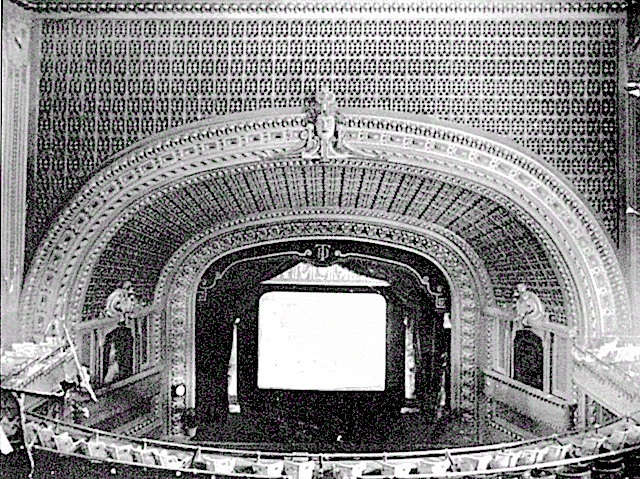 1917 - Stage and front of house show the vast array of tone grlles (Photograph from an archival source: Jim Lewis collection, submitted by Jim Lewis/Jim Lewis)
1917 - Stage and front of house show the vast array of tone grlles (Photograph from an archival source: Jim Lewis collection, submitted by Jim Lewis/Jim Lewis)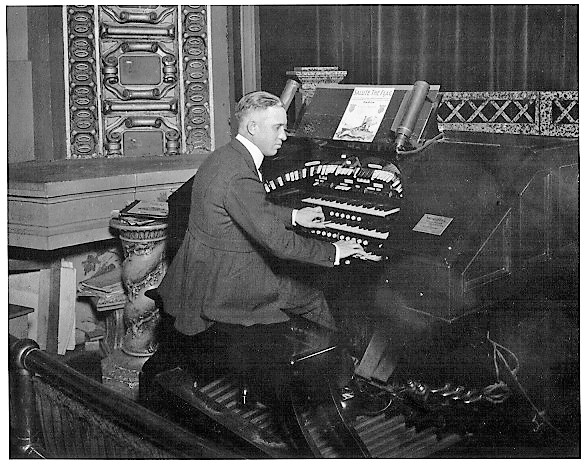 Unknown - Console w/ Unknown Organist--The only known photo of the console while at the T&D (Steve Levin Estate, courtesy of Eric Schmiedeberg (c.1918)/Database Manager)
Unknown - Console w/ Unknown Organist--The only known photo of the console while at the T&D (Steve Levin Estate, courtesy of Eric Schmiedeberg (c.1918)/Database Manager) Unknown - Theatre Exterior (Steve Levin Estate, courtesy of Eric Schmiedeberg (1916)/Database Manager)
Unknown - Theatre Exterior (Steve Levin Estate, courtesy of Eric Schmiedeberg (1916)/Database Manager)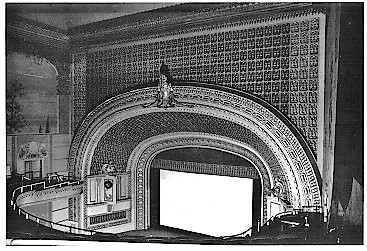 Unknown - Proscenium and Organ Grille (Steve Levin Estate, courtesy of Eric Schmiedeberg (1976)/Database Manager)
Unknown - Proscenium and Organ Grille (Steve Levin Estate, courtesy of Eric Schmiedeberg (1976)/Database Manager) Unknown - Auditorium Interior (Steve Levin Estate, courtesy of Eric Schmiedeberg (1916)/Database Manager)
Unknown - Auditorium Interior (Steve Levin Estate, courtesy of Eric Schmiedeberg (1916)/Database Manager)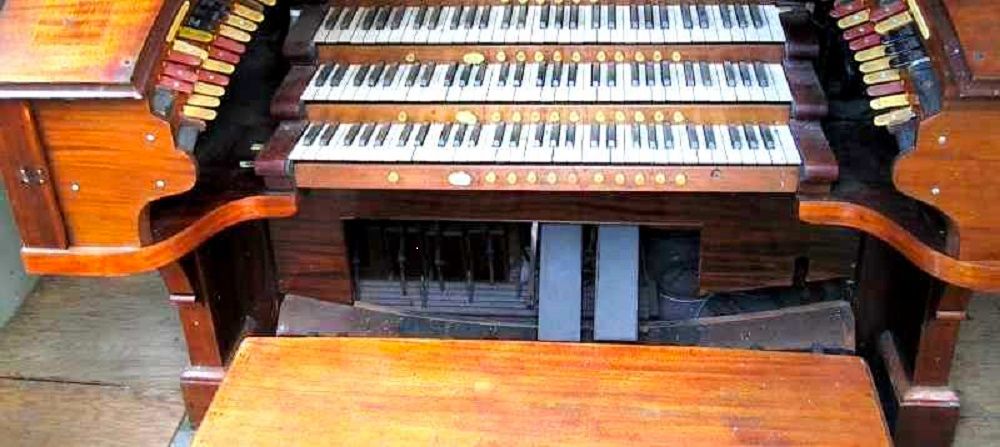 1993-05-01 - Front of Wurlitzer/Hope-Jones Balanced Swell system machine with dowel rod array (Photograph by Eric Schmiedeberg/Database Manager)
1993-05-01 - Front of Wurlitzer/Hope-Jones Balanced Swell system machine with dowel rod array (Photograph by Eric Schmiedeberg/Database Manager)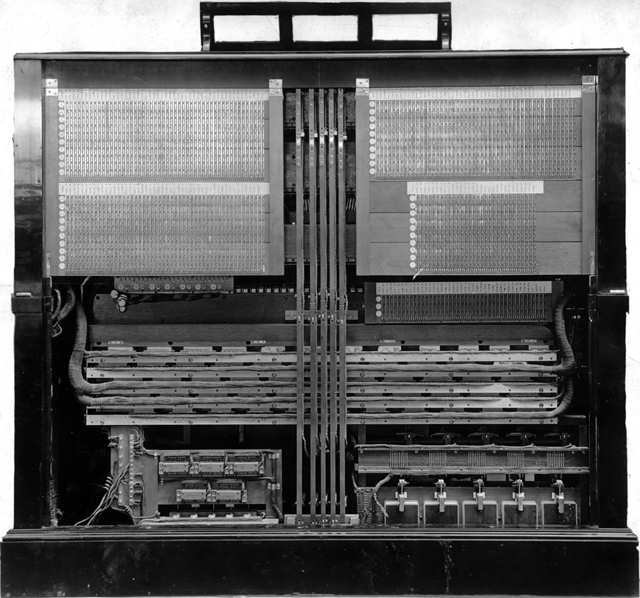 Unknown - Rear View of Console ((1918) Wurlitzer Company Archival Photograph; image courtesy of Eric Schmiedeberg/Database Manager)
Unknown - Rear View of Console ((1918) Wurlitzer Company Archival Photograph; image courtesy of Eric Schmiedeberg/Database Manager)
Consoles
Main
- Organ type: Horseshoe
- Console position: Console in Fixed Position, Left
- 3 manuals
- 15 registers
- 2 divisions
- Key action Type: Electrical
- Stop action Type: Electrical
- Stop layout Type: Stop Keys in Horseshoe Curves
- Manual compass: 61 notes
- Pedal compass: 32 notes
- Pedal Type: Concave Radiating (Details Unknown)
- Expression Type: Balanced Expression Shoes/Pedals (Details Unknown)
- Combination action: Setterboard
- Has combination thumb pistons
- Has combination toe pistons
Notes
2013-10-24 - This entry describes an original installation of a new pipe organ.
Identified by William Dunklin, using information found in David Junchen's The Wurlitzer Pipe Organ, an Illustrated History, p. 612.
-- In 1932 Wurlitzer moved the organ to the United Artists Theatre, Berkeley, California and still later to a residence in San Francisco, California. The T & D closed in 1976 and was torn down shortly afterwards. -Database Manager
2016-01-01 - Updated through online information from Eric Schmiedeberg. <br>I am personally familiar with this instrument. Steve Levin was a good acquaintance of mine who wanted to see this instrument re-installed in a venue that would welcome it. Unfortunately, Steve passed away before that could happen and the instrument was sold and later broken up for parts.<br><br>However, it should be stated for the record that the organ was in very rough shape and would have required numerous pipes to be replaced and everything else overhauled down to the last screw. Its sale was really an economic necessity given the owner it went to after Steve's untimely death.<br><br>This is Wurlitzer's second attempt at building a medium-sized Unit Orchestra capable of filling some of the larger Vaudeville theatres that were beginning to crop up in the mid-teens.<br><br>Until 1915, the Style 6--a 2-3/5 manual 13 rank instrument occupied that position. The Style 35 saw a very short period of manufacture--1915 to 1918, but in that time Wurlitzer got the idea that they had a winning combination of voices to work with in developing a bigger and better version of the 35. That model became known as the Style 260 which first appeared in 1920.<br><br>The observant reader will note that the rank compliments of the 35 and 260 are identical. However, the 260 was a true thoroughbred Unit Orchestra featuring unit manual chests throughout, better pitch selection and full note compasses in all of the ranks.<br><br>The 35 Solo manual was a "straight" one controlling a six-rank ventil chest. These six 49-note ranks could be coupled to any of the other manuals and Pedal. The 35 was loaded with many more couplers than the 260 in order to obtain the most flexibility possible from the straight chest as well as the unit ranks.<br><br>Unification was limited throughout the whole instrument--save a few ranks. The "most bang for the buck" (witness the 32' Diaphones!) yet overall economy-minded design of this model makes one suspect the influence of CEO Howard Wurlitzer who, up until 1923, would be dictating what "made the books" and what didn't. One also suspects that as Wurlitzer's output and notoriety started to grow, Wurlitzer felt that something more expensive and impressive was in order; something more that the market would then bear. Thus, the 260.<br><br>Compared to most of the Wurlitzers people might be familiar with, the 35 stoplist is somewhat bizarre. In a letter to me, Steve called it "positively silurian." Look that one up in your Funk and Wagnall's!<br><br>The organ is also loaded with numerous Robert Hope-Jones-patented mechanisms that would eventually be completely phased out by 1924. These included what I can only call--for want of a better term--"wiggle cancel" Pedal stopkeys and what are Hope-Jones's personal interpretation of "balanced swell pedals". The console also contained a tremulant cancel piston which was featured on no other Wurlitzer model that I know of. The console also contained the Suitable Bass system which is a study in and of itself. That feature would survive throughout the whole era of Wurlitzer Unit Orchestra production--1910 to 1939.<br><br>The "wiggle cancel" stopkeys were part of the Suitable Bass system. This was Hope-Jones's way of supplying the organist with the means of unlocking the system through the manual manipulation of Pedal stops rather than just by the Suitable Bass piston release buttons. The "wiggle" contact would later be supplanted by stop contact wire blocks operated by the Pedal stopkeys.<br><br>Suitable Bass is available through manual thumb pistons with double-touch (Suitable Bass is accessed through second-touch contacts therein), depressing the ovular Suitable Bass piston to first touch or depressing it to second-touch and thereby locking it down. At that point, any registration changes in the manuals accomplished by hand or first-touch piston contact would activate the "ghost hand" that would change Pedal stops on an ongoing basis so as to provide a "suitable bass" for the manual that had its piston (Suitable Bass or second-touch divisional piston) fired. The system is also self-cancelling from manual to manual.<br><br>The system only operates with one manual at a time. What Wurlitzer's idea of "suitable" was and what most organists thought (and think) it should be are and were rarely the same. Also, the system is "hard-wired", so Wurlitzer has the final word in this, pretty much. It will be obvious to anyone who has played a theatre organ that this system does not lend itself very well to that style of playing; left hand accompaniment with right hand melody.<br><br>If you can live with what a suitable bass is for a given Accompaniment manual registration, by Wurlitzer's interpretation, then the system works. Also, the more "concert"/"church"/"classical" technique with both hands on one manual--still the standard in Hope-Jones's time--lends itself more to this system; but there is that pesky Wurlitzer wiring again...........That this system survived in production for as long as it did would suggest that there were organists who found it of some use. If so, those reasons are lost to history.<br><br>The Hope-Jones "balanced" swell pedal alludes not merely to a pedal with a pivoting fulcrum, but a swell that is controlled through the "balance" between an organist's feet and fingers. The swell pedal can be depressed and returned by their foot, or it can be depressed and returned by manually pressing its spring-loaded "bobber" type swell indicator up or down. These are--in Wurlitzers--short wooden posts with celluloid caps that are usually engraved with the name of the swell pedal it is attached to.<br><br>Oddly enough, Opus 99's indicator caps were not engraved. They are located on-center in the top (or maybe only, in the case of the 35) stop rail. A "heads up" display, if you will. The swell pedals are moved through large "push-pull" pneumatics that turn dowel rods linked to the swell pedals. The pneumatic engine unit went out of production in '23, but if the later versions of the Wurlitzer "bobber" indicator systems are well-lubricated and properly adjusted, the indicators can still be used to operate the swells. I have tried this on a number of Wurlitzers, and it works!<br><br> I have it on good authority that the last such "balanced swell" pedal mechanism encountered in Wurlitzer production was actually incorporated as a retrofit to Opus 998 (1925) at Roosevelt Memorial Park cemetery in Gardena, California. Like--perhaps--the Suitable Bass system, the Hope-Jones Balanced Swell was seen as useful to one or a number of organists there. On-site retrofits are usually very expensive and Wurlitzer commanded premium prices in their heyday. This particular system was usually incorporated in consoles containing five swell pedals (not counting Crescendo). Roosevelt Memorial Park's console was one of these.<br><br>Given this sprawling swell control scheme one can see where a visual/manual way of wrangling it might be useful. Especially with "exterminator" ranks on 35 and 50" wind lurking in the Brass and Foundation chambers. With only two expression pedals, one might wonder why this complex system would have been bothered with in the 35.<br><br>Up until 1924 Wurlitzer was still committed in many ways to the Hope-Jones patents that they had bought from Hope-Jones when he came to work for them in 1910. A marketing scheme ("Exclusive Wurlitzer/Hope-Jones Patents!) and Wurlitzer's desire to "get their money's worth" (mainly Howard Wurlitzer again) seem to be the most plausible theories as to why. The years 1924 to 1925 saw the abandonment of numerous Hope-Jones designs that proved to be added expense for little resulting adaptation or popularity among organists. The year 1925 also saw Hope-Jones's name erased from the builder's plates on the consoles. Similarly, the Style 35 is now extinct having been erased from the list of surviving Wurlitzer model specimens. <br>Accompaniment and Great manuals are standard 61-note compass. The Solo keyboard (top keyboard)is 37 notes in compass centered over the two below. -Database Manager
2016-03-02 - Updated through online information from Eric Schmiedeberg. <br>There is at least one more Wurlitzer theatre organ that was built after Opus 998 that featured the "Balanced Swell" push-pull pneumatic array. This being Opus 1066 (1925) shipped to the Uptown Theatre in Chicago. Being that the 1925 Wurlitzer shipped to Shea's Buffalo Theatre in Buffalo, NY was a twin to that in the Uptown, it is reasonable to believe that that instrument also incorporated this system. It is unknown whether it was retained when that organ was overhauled in modern times, however.<br><br>It is also possible that the 1927 replacement console for the Missouri Theatre 4/32 Wurlitzer (1921) featured it was well. It would seem that the system actually ceased to be a production item once Wurlitzer's 4/32 Style 285 was phased out of the product line in 1925. -Database Manager
2016-03-16 - Updated through online information from Eric Schmiedeberg. <br>The photo to the left is of the rear of the four-manual console that controlled the Wurlitzer organ in the Denver Municipal Auditorium. As an example, it shows the rear of the Wurlitzer/Hope Jones "Balanced Swell" system machine at lower left. The pneumatics shown operated the swell pedal linkages that caused the console's swell pedals to depress when the organist manipulated the swell indicator "bobbers" manually thereby allowing the organist to control the organ's swell pedals by hand.<br><br>There is a corresponding set of pneumatics on the other side of the machine that returned the swell pedals to "closed" position. The pneumatics are connected to a row of dowels. Each dowel rotated each way when its corresponding pneumatic pair pushed or pulled it. This system was utilized from 1910-1925 in Wurlitzer's "deluxe" instruments; whatever that happened to be in a given period of their theatre organ production history. -Database Manager
2018-07-25 - Information from <i>The Wurlitzer Pipe Organ – An Illustrated History</i> by David L. Junchen (comp. & ed. Jeff Weiler). The American Theatre Organ Society, 2005.<br>
Wurlitzer Style 35<br>
Factory date: September 13, 1916<br>
Moved in 1932 to United Artists Theatre, Berkeley, California -Database Manager
Stoplist
Stoplist taken from console photo Source: Source not recorded Date not recorded
Oakland, California, USA
T&D Theatre
Rudolph Wurlitzer Manufacturing Co.
Opus 99--Shipped September 13, 1916
PEDAL ACCOMPANIMENT GREAT
16' Contra Viol TC 16' Ophicleide
32' Diaphone 8' Tuba Horn 16' Diaphonic Diapason
16' Ophicleide 8' Diaphonic Diapason 16' Bass (Flute)
16' Diaphone 8' Clarinet 16' Clarinet TC
16' Bass (Flute) 8' Saxophone 16' Contra Viol
8' Tuba Horn 8' String (Solo String) 8' Tuba Horn
8' Octave (Diaphonic Diapason) 8' Viol d' Orchestre 8' Diaphonic Diapason
8' Clarinet 8' Viol Celeste 8' Clarinet
8' Saxophone 8' Flute 8' Saxophone
8' Cello (Viol d' Orchestre and Celeste) 8' Vox Humana 8' String (Solo String)
8' Flute 4' Viol 8' Viol d' Orchestre
4' Flute 4' Octave Celeste 8' Viol Celeste
Bass Drum 4' Flute 8' Flute
Kettle Drum (Reit. Bass Drum) 2-2/3' Twelfth (Flute) 8' Vox Humana
Snare Drum 2' Piccolo (Flute) 4' Clarion (Tuba)
Crash Cymbal Harp* 4' Viol
Cymbal Chrysoglott** 4' Octave Celeste
Snare Drum 4' Flute
Tambourine 2-2/3' Twelfth (Flute)
Castanets 2' Fifteenth (VDO)
Chinese Block 2' Piccolo (Flute)
SOLO--37-note compass Tom Tom 1-3/5' Tierce (Flute)
8' Tibia Clausa Harp
8' Trumpet Chrysoglott
8' Orchestral Oboe Bells***
8' Kinura Sleigh Bells (tuned)
8' Oboe Horn Xylophone
8' Quintadena**** Glockenspiel
Cathedral Chimes
Bells
Sleigh Bells (tuned)
Xylophone
Glockenspiel
BACK RAIL--Stop groupings are reflected in stop tab groupings in this specification.
Pedal--Second Touch Great Second Touches SWELL PEDALS
32' Diaphone 16' Ophicleide Main
Solo
Solo to Great --No crescendo pedal--
Pedal--Pizzicato Touch Great--Pizzicato Touch SWELL INDICATORS--"Bobber" Type
16'Ophicleide Solo to Great --Fitted for "Balanced Swell" System--
Great to Pedal Octave TOE STUDS
Solo to Pedal Solo to Great Pedal Combos 1-3
Effects 1-4
--Section #2--
Accompaniment Second Touches (Solo--First Touch)
8' Tuba Horn Octave Effects 5-9
Cathedral Chimes
Sleigh Bells (tuned)
Xylophone Tremulants
Triangle Main
Solo to Accompaniment Solo
Vox
Accompaniment--Pizzicato Touch
Solo to Accompaniment
Solo to Accompaniment
COMBINATION ACTION
Pedal--Toe Pistons--1-3
Accomp.--10 Double-Touch pistons--PP/P/MF/F/FF & 1-5
Double-touch lockable Suitable Bass piston and release piston
Great--10 Double-touch pistons--P/MF/F/FF/FFF & 1-5
Double-touch lockable Suitable Bass piston and release piston
Solo--1-6
Tremulant Cancel
NOTES--
*This is the familiar Wurlitzer Marimba/Harp, but without reit. contacts for the "Marimba" function.
**This Chrysoglott would have exhibited a very different timbre than Wurlitzer's steel-bar examples. The earlier Chrysoglotts used aluminum bars.
These are easily identified by their rounded ends as opposed to the squared-off steel types.
***The "Bells" stop keys in this organ do not control the typical reiterating Glockenspiel.
They control a set of what can only be described as "tuned door bells".
Door bells like one would have found in those days; a metal cup with a electrically reiterating striker.
****According to "those in the know" the Quintadena in this organ was exceptionally bright in timbre. Robert Hope-Jones originally intended that his version of the Quintadena voice would put back
some of the harmonic content and tonal brilliance in his instruments that was lost when he omitted the use of mixtures from his specifications. This bright Quintadena tone is perhaps one of the other Hope-Jones ideas that Wurlitzer reinterpreted in the subsequent years following Hope-Jones' death in 1914.
See Colin Pykett's interesting commentary on this at pykett.org.uk There are a number of other interesting articles that he has written about Robert Hope-Jones there in his "Complete Articles" section. This is an interesting site and a real "candy store" for those who love organs of all kinds and want to dig deeper into the engineering, history and so on of the King of Instruments".
[Received from Eric Schmiedeberg 2016-03-04.]
Related Pipe Organ Database Entries
Other Links
Regrettably, it is not possible to display the information about the sponsor of this pipeorgandatabase entry or if there is a sponsor. Please see About Sponsors on Pipe Organ Database.






